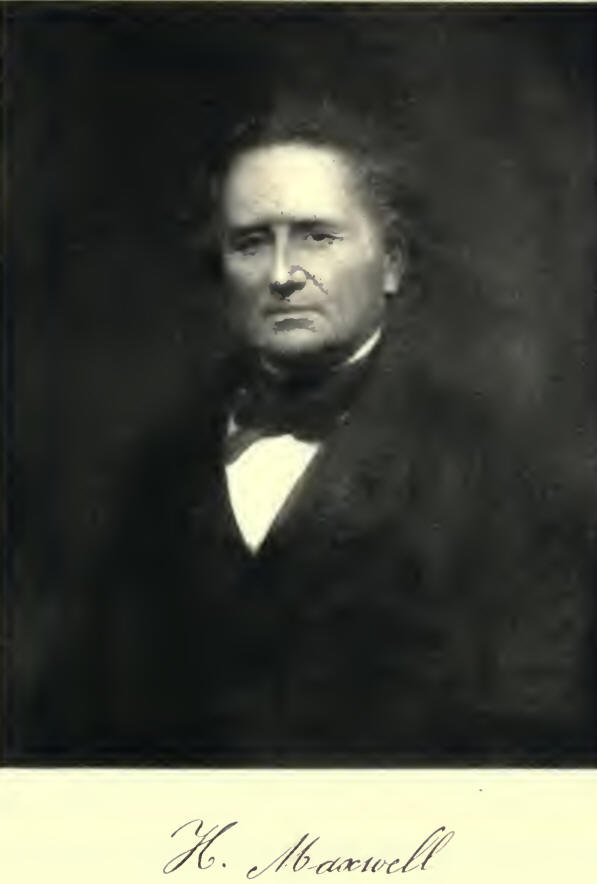|

Twenty-second President
1835-1837.
The Maxwells formed a
powerful border family in the south of Scotland and at one time claimed
to be the Earls of Nithsdale, having obtained the title for adherence to
the cause of the Stuarts in 1716.
Hugh Maxwell was the son
of William Maxwell and was born in 1787 at Paisley, Scotland. He died on
the 31st March, 1873, at his residence, No. 14 St. Marks Place, in New
York City, at the advanced age of eighty-six years.
His father, William
Maxwell, came to this country in 1790, bringing with him his small
family and his son Hugh, then three years of age. Hugh Maxwell received
a sound education in the public school and entered Columbia College,
whence he graduated in 1808.
Gulian C. Verplanck was
one of his classmates and an intimate friend, and was associated with
him in a curious affair which created great excitement and comment at
the time. At the class commencement day, one of the graduates, in the
course of his oration, expressed political sentiments in opposition to
those held by the faculty. That august body thereupon peremptorily
refused the young orator his degree and the usual college honors. Both
Mr. Verplanck and Mr. Maxwell roundly denounced such action as arbitrary
and unjust— sentiments which a number of their fellow-students
sustained—and the affair rapidly took an important turn. The young men
were indicted for inciting a riot, and Mr. DeWitt Clinton, the then
Mayor of New York, in his charge to the jury, vehemently denounced the
conduct of the students. Public sentiment, however, was aroused and the
newspapers declared in favor of the accused and severely criticized the
Columbia College faculty for their illiberal views and arbitrary action,
stating that a university should advocate and favor no particular
political creed. Eventually the matter was settled by fining the
principals, among whom Messrs. Verplanck and Maxwell ranked as the
leaders.
Mr. Maxwell immediately
thereafter took up the study of law, was admitted to the bar and began
practice in 1808. He soon built up a lucrative practice, but shortly
after the outbreak of the War of 1812 with Great Britain he entered the
United States Army in his first public position as Assistant Junior
Advocate General in 1814.
At the close of the war
he identified himself with politics and in 1819 was elected District
Attorney for the City of New York. He held this office, which afforded
him every opportunity of displaying his brilliant powers of argument and
oratory, by successive reelections until 1829. Among the most celebrated
of the cases tried bv him was the so-called "Conspiracy Trial” in 1823,
in which Jacob Varker, a well-known Quaker banker, Henry Eckford, a
prominent ship-builder, and several others were charged with conspiring
to defraud certain insurance companies. Notwithstanding the strong array
of legal talent retained for the defense, Mr. Maxwell succeeded in
securing the conviction of a majority of the accused. During these
trials he distinguished himself and increased his reputation as a clear,
erudite and powerful public speaker.
Fitzgreen Halleck, the
poet, however, wrote several stanzas upon these trials in which he
severely censured the course of “MacSurll,” the pseudonym for Mr.
Maxwell.
In appreciation of his
valued services as District Attorney the merchants of the city presented
him with a costly silver vase, which Mr. Maxwell in his will bequeathed
to the New York Law Institute, where it may now be seen.
After his term of office
had expired Mr. Maxwell again took up the private practice of law and
for twenty years occupied a prominent position at the bar of this State.
He also became an active and ardent Whig, and was of great use to his
political party. His political services were such that President Taylor
appointed him as Collector of the Port of New York, and he held this
position from 1849 to 1852, through the administrations of Presidents
Taylor and Fillmore. Soon after this last date Mr. Maxwell retired from
active life and occupied himself with literary and kindred pursuits
until his death. He had a great love for classic literature and his
library contained one of the best private collections in the city. It
was there he passed the autumn of his life, surrounded by his old
friends, among whom were numbered Thurlow Weed, William C. Rhinelander
and James Lenox.
He was a member of the
New York Historical Society and was elected a member of Saint Andrew’s
Society on 30th November, 1811. He served as a Manager from 1826-1828;
as Second Vice-President, 1828-1832; as First Vice-President from
1832-1835, and as President from 1835-1837. Thereafter he served on the
Standing Committee in 1845 and 1850 and the Committee of Installment in
1848 and 1849.
It was during his term as
President in 1835 that he found in a New York junk shop the marble slab
belonging to the monument erected to Alexander Hamilton by the Society,
and which he purchased and sent to James Gore King, the then owner of
the Weehawken property where the monument stood. This slab was
eventually purchased by the New York Historical Society, where it can
now be seen.
He married in New York
City Agnes Stevenson, and had issue, all born in New York City: (1)
Hugh; (2) John Stevenson; (3) Ann Eliza; (4) Agnes.
His portrait is
reproduced from an oil painting now in the possession of his
daughter-in-law, Mrs. Hugh Maxwell. |
